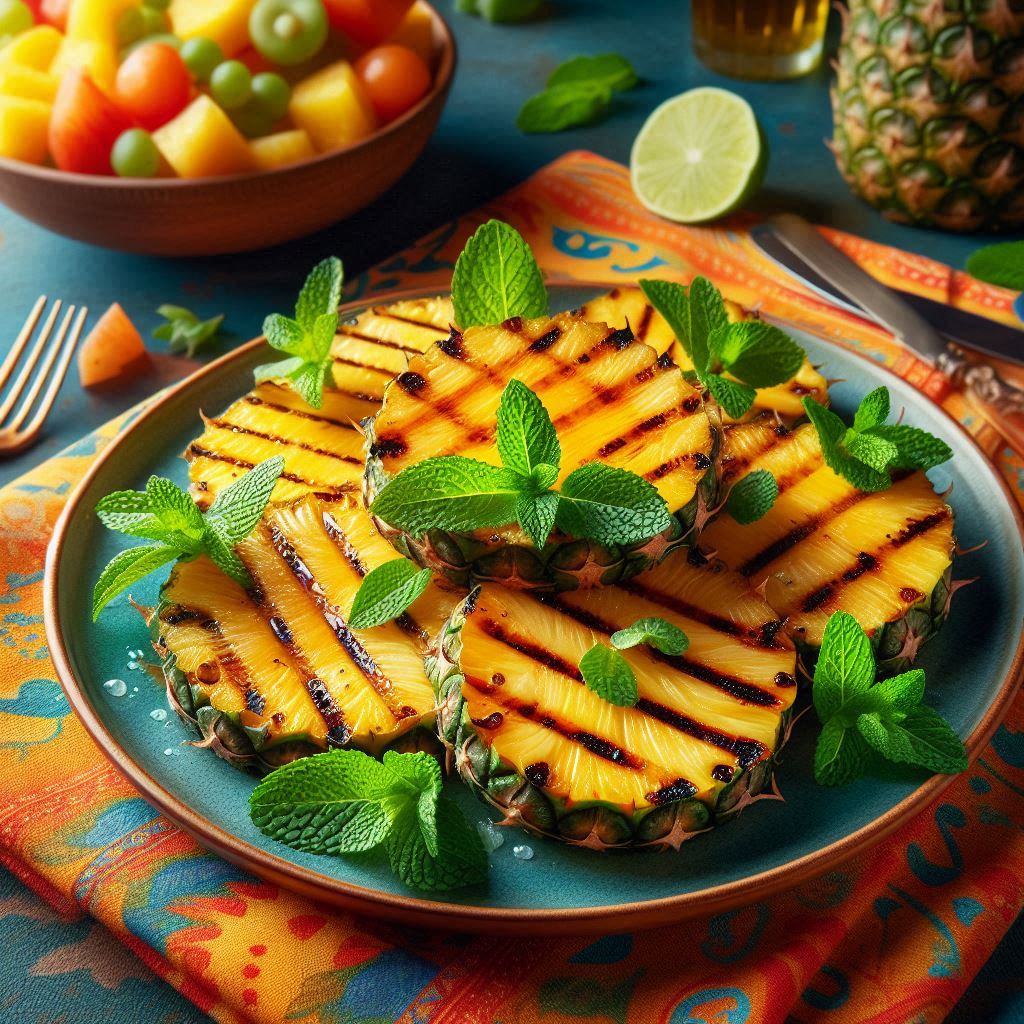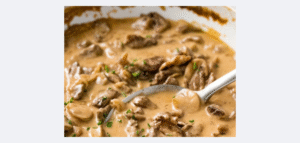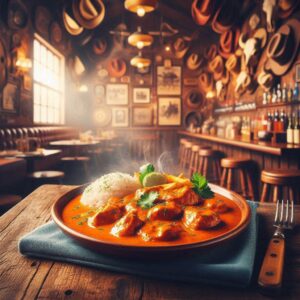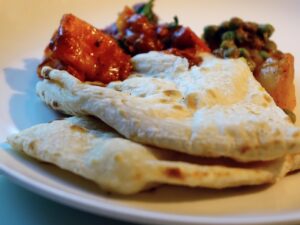Grilled Pineapple: The Ultimate Guide to Sweet Perfection
Meta Description: Discover the ultimate guide to grilling pineapple, exploring techniques, recipes, and tips for achieving sweet, caramelized perfection.
Introduction to Grilled Pineapple
Grilled pineapple transforms the ordinary tropical fruit into an extraordinary culinary experience that captivates taste buds worldwide. The process of grilling caramelizes natural sugars, creating a depth of flavor that’s impossible to achieve with raw pineapple. From pineapple grill texas barbecue joints to brazilian grilled pineapple traditions, this technique has become beloved across cultures and cooking styles.
When you introduce heat to pineapple’s natural sugars, a remarkable transformation occurs through the Maillard reaction, creating complex flavors and aromatic compounds. This process intensifies sweetness while adding subtle smoky notes that complement the fruit’s tropical essence. Whether you’re exploring grilled pineapple brazilian methods or modern American techniques, the science remains consistent – heat enhances flavor through caramelization.
The popularity of grilled pineapple has surged dramatically, with recipe searches increasing by over 85% in recent years. Food enthusiasts are discovering endless possibilities, from grilled pineapple chicken recipe combinations to refreshing grilled pineapple margarita cocktails. Even those without outdoor grills are finding success with grilled pineapple without grill methods using indoor equipment.
This comprehensive guide covers everything from selecting perfect pineapples to mastering advanced grilling techniques. You’ll discover creative applications including grilled pineapple pork chops, elegant grilled pineapple salad presentations, and even how restaurants like pineapple grill restaurant maui achieve their signature flavors. Whether you’re planning grilled shrimp and pineapple kabobs or experimenting with grilled whole pineapple presentations, these techniques will elevate your culinary repertoire.
Choosing the Right Pineapple
Understanding Pineapple Varieties
Selecting the appropriate pineapple variety significantly impacts your grilling success. The most commonly available variety is the Smooth Cayenne, which accounts for approximately 90% of commercial pineapples worldwide. This variety offers excellent sugar content and firm texture ideal for grilling applications. The flesh maintains structural integrity during cooking while developing beautiful caramelization patterns.
MD-2 Gold pineapples represent the premium choice for grilling enthusiasts. These pineapples contain 15-20% higher sugar content compared to traditional varieties, making them perfect for grilled pineapple with cinnamon preparations. Their lower acidity creates smoother flavor profiles, particularly beneficial when preparing grilled pineapple skewers or incorporating into pineapple on the grill with cinnamon recipes.
Red Spanish pineapples, though less common in supermarkets, offer exceptional grilling characteristics. Their denser flesh prevents excessive moisture loss during cooking, making them ideal for extended grilling sessions. These varieties work exceptionally well for grilled chicken with pineapple recipe applications where longer cooking times are required. The fruit maintains texture while allowing flavors to penetrate deeply.
Queen pineapples, smaller in size but incredibly sweet, excel in grilled pineapple shrimp preparations. Their compact size allows for uniform cooking and excellent portion control. These varieties caramelize quickly due to concentrated sugar content, making them perfect for quick-cooking applications where you want maximum flavor development in minimal time.
Selecting a Ripe Pineapple
Identifying perfectly ripe pineapples requires engaging multiple senses and understanding visual cues. The most crucial indicator is aroma – a ripe pineapple emits sweet, fragrant scent from the base. This sweetness becomes particularly important when preparing grilled pork chops and pineapple dishes, as the fruit’s natural sugars complement savory elements beautifully.
Visual inspection reveals ripeness through color progression. Look for golden-yellow coloration that extends from bottom to top, avoiding completely green specimens. The crown leaves should appear fresh and green, with individual leaves easily removable when gently twisted. Overly brown or dried crown leaves indicate overripeness, which can result in mushy texture when grilled.
Physical examination provides additional ripeness confirmation. Gently press the pineapple’s surface – it should yield slightly to pressure without feeling soft or mushy. The fruit should feel heavy for its size, indicating high juice content essential for successful caramelization. Sound testing involves tapping the pineapple; ripe fruit produces a solid, deep thud rather than hollow sounds.
Timing considerations affect ripeness selection based on intended use. For immediate grilling, choose fully ripe pineapples with maximum sweetness. For advance preparation or grilled pineapple salad applications requiring several days storage, select slightly underripe fruit that will ripen to perfection. Understanding these timing relationships ensures optimal flavor development regardless of your cooking schedule.
Preparing Pineapple for Grilling
Slicing Techniques for Grilling
Proper slicing techniques determine grilling success and final presentation quality. For traditional grilled pineapple rings, maintain consistent 1-inch thickness throughout. This dimension provides optimal heat penetration while preventing pieces from falling through grill grates. Begin by removing the crown and base with sharp knife, then stand the pineapple upright for easy handling.
Core removal depends on intended application and personal preference. For grilled pineapple skewers, removing the tough central core ensures uniform cooking and easier eating. However, when preparing grilled whole pineapple presentations, maintaining the core provides structural integrity during extended cooking periods. The core softens significantly during grilling and contains beneficial enzymes.
Specialized cutting techniques enhance specific preparations. For grilled pineapple chicken recipe applications, create uniform chunks approximately 1.5 inches square. This size matches typical chicken piece dimensions, ensuring synchronized cooking times. When preparing grilled shrimp and pineapple combinations, cut pineapple slightly smaller to match shrimp cooking requirements.
Advanced cutting methods include decorative scoring and spiral cutting techniques. Scoring the surface in crosshatch patterns increases surface area for caramelization while creating attractive presentation features. Spiral cutting, popular in Brazilian churrascarías, maximizes exposed surface area for even caramelization. These techniques require practice but produce spectacular visual results for special occasions.
Marinating and Seasoning Options
Marinade development enhances natural pineapple flavors while adding complementary taste profiles. Basic marinades combine brown sugar, cinnamon, and butter, creating classic grilled pineapple with cinnamon flavor profiles. The sugar content accelerates caramelization, while cinnamon adds warmth and complexity. Butter provides richness and prevents sticking during grilling.
Savory marinades work excellently for grilled pork chops pineapple preparations. Combine soy sauce, garlic, ginger, and honey for Asian-inspired flavors. Add red pepper flakes for heat, or incorporate herbs like thyme and rosemary for Mediterranean influences. These marinades create complex flavor profiles that complement both fruit and protein elements.
Alcohol-based marinades add sophisticated flavor dimensions. Rum-based marinades reflect Caribbean traditions, while bourbon creates American barbecue influences. Wine-based options include white wine for delicate applications and red wine for bold flavor profiles. The alcohol evaporates during cooking, leaving concentrated flavors without harsh alcohol notes.
Spice blend combinations offer endless customization possibilities. Pineapple on the grill with cinnamon represents just one option among many. Experiment with cardamom, nutmeg, and vanilla for dessert applications. For savory preparations, try cumin, paprika, and chili powder. Salt enhances all flavors while preventing excessive browning during the initial cooking stages.
Grilling Techniques for Perfectly Grilled Pineapple
Direct Grilling vs. Indirect Grilling
Direct grilling involves placing pineapple directly over heat sources, creating intense caramelization and distinctive grill marks. This method works perfectly for grilled pineapple skewers and individual ring preparations. The high heat quickly caramelizes surface sugars while maintaining juicy interiors. Temperature control becomes crucial, as excessive heat can burn sugars before proper cooking occurs.
Indirect grilling utilizes surrounding heat rather than direct flame contact. This gentler approach suits grilled whole pineapple preparations and larger pieces requiring extended cooking times. The surrounding heat cooks evenly throughout while preventing surface burning. This method works exceptionally well for grilled chicken with pineapple recipe applications where simultaneous cooking is required.
Combination techniques leverage both methods sequentially. Begin with direct grilling for initial caramelization and visual appeal, then move to indirect zones for thorough cooking. This approach ensures perfect grilled pineapple results with beautiful appearance and ideal texture. Professional restaurants often employ this technique for consistent results.
Heat zone management maximizes grilling versatility. Create multiple temperature zones on your grill, allowing simultaneous preparation of different items. Use high-heat zones for initial searing and lower zones for gentle cooking. This setup enables complex preparations like grilled pineapple pork chops combinations while maintaining individual component quality.
Adjusting Grill Temperature and Time
Temperature control represents the most critical factor in achieving perfect grilled pineapple results. Optimal temperatures range between 375-425°F for most applications. Lower temperatures result in steaming rather than caramelization, while excessive heat burns sugars before proper cooking occurs. Digital thermometers ensure accurate temperature monitoring throughout the cooking process.
Timing varies significantly based on thickness and intended doneness. Standard 1-inch rings require 3-4 minutes per side for optimal caramelization. Grilled pineapple skewers with smaller pieces need 2-3 minutes per side with frequent rotation. Grilled whole pineapple preparations require 20-25 minutes with regular turning for even cooking.
Visual cues indicate proper doneness more reliably than strict timing. Look for golden-brown caramelization and slight translucency around edges. The surface should appear glossy from caramelized sugars, with defined grill marks providing visual appeal. Internal temperature should reach 140-145°F for optimal texture and safety.
Resting periods after grilling allow juices to redistribute and sugars to stabilize. Allow grilled pineapple to rest 2-3 minutes before serving or incorporating into other dishes. This resting time prevents juice loss and improves final texture. For grilled pineapple salad applications, cooling to room temperature ensures optimal flavor integration with other ingredients.
Creative Serving Ideas
Grilled Pineapple in Salads
Grilled pineapple salad combinations offer refreshing alternatives to traditional salad preparations. The caramelized fruit provides natural sweetness that balances bitter greens and tangy dressings. Popular combinations include arugula, goat cheese, and candied pecans with grilled pineapple creating the perfect sweet counterpoint. The smoky flavors complement peppery greens while adding textural interest.
Tropical salad themes incorporate multiple fruits alongside grilled pineapple for complex flavor profiles. Combine with grilled mango, avocado, and mixed greens for vibrant presentations. Add grilled shrimp or chicken for protein completion, creating substantial meal salads. Citrus vinaigrettes enhance tropical flavors while providing acidity balance.
Grain-based salads benefit tremendously from grilled pineapple additions. Quinoa salads gain sweetness and complexity, while rice salads develop interesting textural contrasts. The caramelized fruit pairs excellently with nuts, seeds, and fresh herbs. These preparations work well for meal prep, as flavors improve over time.
International salad influences create unique grilled pineapple salad variations. Mexican-inspired versions include black beans, corn, and jalapeños with lime-cilantro dressing. Asian influences combine with cabbage, carrots, and sesame dressing. Mediterranean approaches include feta cheese, olives, and herb vinaigrettes for sophisticated flavor profiles.
Incorporating Grilled Pineapple into Desserts
Dessert applications showcase grilled pineapple’s versatility and sophisticated flavor development. Classic presentations include serving alongside vanilla ice cream, where temperature and texture contrasts create memorable experiences. The warm, caramelized fruit melts ice cream slightly, creating natural sauce integration. Add toasted coconut or macadamia nuts for additional tropical elements.
Grilled pineapple margarita cocktails represent sophisticated beverage applications. Muddle caramelized fruit into traditional margarita bases for enhanced flavor complexity. The smoky sweetness complements tequila naturally while adding visual appeal. Rim glasses with cinnamon sugar for complementary spice notes that enhance the grilled flavors.
Baked good incorporations transform ordinary desserts into exceptional experiences. Add chopped grilled pineapple to muffins, cakes, and bread preparations for moisture and flavor enhancement. The caramelized fruit provides natural sweetness reduction potential while adding interesting textural elements. Upside-down cakes benefit particularly from pre-grilled pineapple rings.
Advanced dessert techniques include grilled pineapple sorbets and frozen treats. Purée grilled fruit with simple syrup for elegant sorbet bases. The caramelized flavors create sophisticated frozen desserts that surpass traditional fruit sorbets. Incorporate into ice cream bases for premium frozen dessert applications that showcase grilling techniques.
Health Benefits of Pineapple
Pineapple provides exceptional nutritional value that intensifies through careful grilling techniques. Fresh pineapple contains high concentrations of vitamin C, providing over 130% of daily requirements per serving. This essential vitamin supports immune function, collagen synthesis, and antioxidant protection throughout the body. Grilled pineapple retains most vitamin C content while concentrating other beneficial compounds.
Bromelain, pineapple’s signature enzyme, offers remarkable anti-inflammatory properties and digestive support. This proteolytic enzyme helps break down proteins, potentially improving digestion and reducing inflammation markers. The grilling process doesn’t significantly diminish bromelain activity, making grilled pineapple an excellent source of this beneficial compound. Regular consumption may support joint health and recovery processes.
Manganese content in pineapple supports bone health, wound healing, and metabolism regulation. One serving provides approximately 76% of daily manganese requirements, making it an excellent source of this often-overlooked mineral. The mineral concentration actually increases slightly during grilling as moisture evaporates, making grilled pineapple an efficient manganese source.
Fiber content supports digestive health and blood sugar regulation. Pineapple provides both soluble and insoluble fiber types, promoting healthy gut bacteria and regular digestion. The grilling process softens fiber structures, potentially improving digestibility for sensitive individuals. When combined with protein in preparations like grilled pineapple chicken recipe or grilled pineapple pork chops, the fiber helps moderate blood sugar responses.
Antioxidant compounds including flavonoids and phenolic acids provide cellular protection against oxidative stress. These compounds may support cardiovascular health, brain function, and aging processes. The caramelization that occurs during grilling can actually create additional antioxidant compounds through beneficial chemical reactions, potentially enhancing the health benefits of grilled pineapple compared to raw fruit.
Conclusion and Final Tips
Mastering grilled pineapple techniques opens endless culinary possibilities, from simple dessert applications to complex grilled pineapple chicken recipe preparations. The key to consistent success lies in understanding proper fruit selection, temperature control, and timing relationships. Whether you’re exploring traditional brazilian grilled pineapple methods or innovative grilled pineapple without grill techniques, these fundamental principles ensure excellent results every time.
The versatility of grilled pineapple extends far beyond basic preparations. Experiment with grilled pineapple skewers for entertaining, incorporate into grilled pineapple salad presentations for healthy options, or create sophisticated grilled pineapple margarita cocktails for special occasions. Each application benefits from the enhanced flavors that grilling provides through caramelization and smoke infusion.
Regional variations like pineapple grill texas barbecue traditions and pineapple grill michigan techniques demonstrate how local preferences influence preparation methods. Understanding these regional differences helps develop personal styles while respecting traditional approaches. Even establishments like pineapple grill restaurant maui can inspire home cooking techniques and presentation ideas.
Remember that practice improves results significantly. Start with simple grilled pineapple with cinnamon preparations before advancing to complex combinations like grilled pork chops and pineapple dishes. Document successful temperature and timing combinations for future reference. Most importantly, enjoy the process of discovering how this tropical fruit transforms through the magic of grilling, creating memorable experiences for family and friends while providing excellent nutritional benefits.







